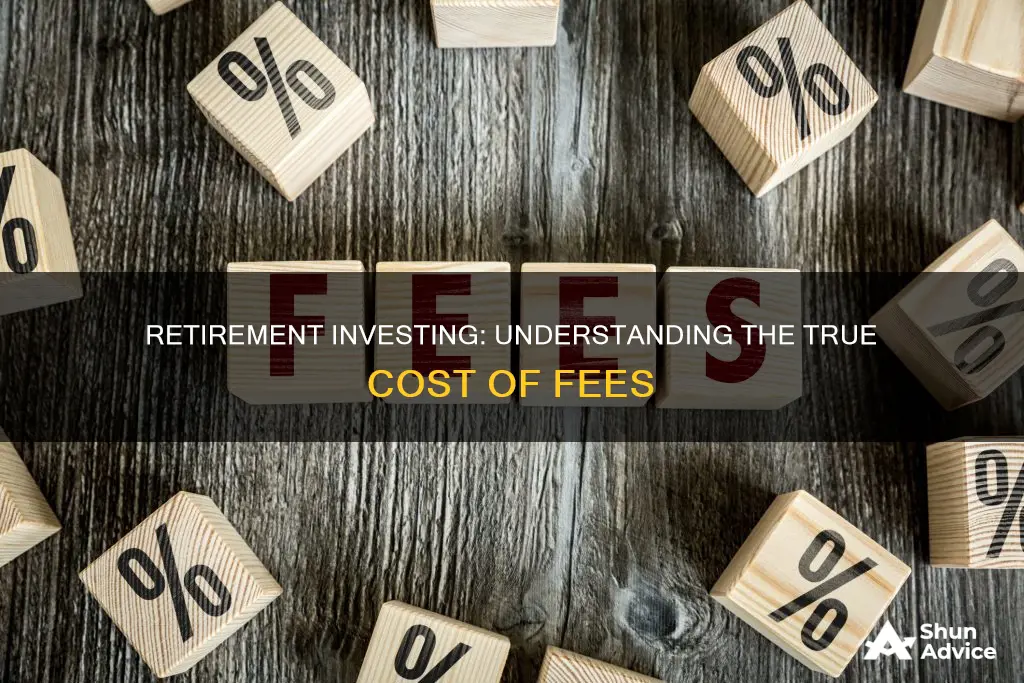
Retirement investing fees can have a significant impact on your investment performance and overall wealth. These fees, which cover important costs associated with managing your investments, can be structured as one-time or recurring charges. When considering the appropriateness of fees, it's crucial to look beyond the initial cost and understand the long-term value and overall expense of the investment.
The types of fees vary and can include management fees, advisory fees, broker fees, and trading fees. Some common retirement investment fees are front-end loads, back-end loads, no-load funds, and expense ratios. These fees can be categorized into three main groups: investment fees, administration fees, and individual service fees.
Investment fees are paid from fund expenses and can be divided into shareholder fees and operating expenses. Shareholder fees apply to individual transactions and account maintenance, while operating expenses cover regular fund expenses such as management fees and distribution fees. Administration fees cover the operational aspects of running a 401(k) plan, including record-keeping, legal services, and customer support. Individual service fees are charged for specific services or features that an investor chooses to use, such as taking out a loan from their 401(k) or rolling over their 401(k) assets into an IRA.
It is essential to carefully consider and understand the fees associated with retirement investing to make informed decisions and ensure your investments align with your financial goals.
| Characteristics | Values |
|---|---|
| Investment fees | 0.03% - 2% of plan assets |
| Administration fees | Direct or indirect fees |
| Individual service fees | $20 to over $150 |
What You'll Learn

Investment fees
Types of Investment Fees:
- Shareholder Fees: These fees are associated with individual investor transactions and account maintenance. Examples include sales loads (commissions paid to brokers), redemption fees (deducted when selling fund shares), purchase fees (charged when buying fund shares), exchange fees (imposed when exchanging fund shares), and account fees (imposed when an account falls below a minimum balance).
- Operating Expenses: These fees cover regular and recurring fund expenses, such as management fees (paid to the fund's investment advisor), distribution and/or service 12b-1 fees (for marketing and selling fund shares), and other expenses like legal, accounting, and administrative costs.
- Transaction Fees: These are charges incurred every time an investor buys, sells, or exchanges shares of a stock or ETF. They can vary depending on the platform and services used, ranging from less than $5 to more than $20 per transaction.
- Trading Fees: These are one-time charges, similar to transaction fees, but often structured as a flat fee, such as a $2 fee for each trade.
- Management Fees: Paid to the fund's investment advisor, these fees are usually charged as a percentage of the assets under management (AUM). They cover expenses such as office space, research, and salaries.
- Advisory Fees: These fees are paid to financial advisors or investment professionals for their services. They can be structured as recurring commissions, flat fees, or hourly rates.
- Broker Fees: Charges for the services provided by brokers, who facilitate the buying and selling of investments.
Impact of Investment Fees on Retirement Savings:
Additionally, mutual fund fees can further decrease your wealth. If the mutual funds in your portfolio also charge a 1% expense ratio, your wealth could be further reduced to around $3.2 million. Therefore, it is crucial to consider the long-term impact of investment fees when planning for retirement.
Tools for Evaluating Investment Fees:
To make informed decisions, it is essential to understand the investment fees you are currently paying. You can find this information in the prospectus provided by your investment company or on their website. Additionally, tools like Personal Capital's Retirement Fee Analyzer can help you evaluate your investment costs by calculating the weighted average expense ratio for your entire portfolio.
In summary, investment fees are an important aspect of retirement investing. By understanding the different types of fees and their potential impact on your returns, you can make more informed decisions to optimize your portfolio and maximize your retirement savings.
Investing: Why the Fear?
You may want to see also

Administration fees
Direct administration fees are usually paid by the plan sponsor or deducted from participant accounts. If administration costs are charged separately, they will either be charged against your employer or against the assets of your plan. However, these fees are typically passed on to the employee as a flat fee or a percentage of their assets invested. Administrative fees are then allocated among individual accounts in proportion to their account balances or as a flat fee against each participant's account.
Asset-based administration fees are considered unnecessary and can lead to participants overpaying for plan administration services. Administration fees that are a percentage of plan assets should ideally cover only asset custody, as administration services scale with employee headcount rather than assets.
Indirect administration fees are often referred to as "hidden" 401(k) fees due to their lack of transparency. They come in two forms: revenue sharing and "wrap" fees. Revenue sharing involves adding non-investment-related fees to the operating expenses of a mutual fund, which are then paid out to plan service providers. "Wrap" fees are added by insurance companies that use variable annuities instead of mutual funds as 401(k) investments. A variable annuity includes a thin layer of insurance with additional fees and redemption restrictions.
The Debt-First Dilemma: Why Paying Off Debt Should Precede Investment Plans
You may want to see also

Individual service fees
Some of these extra features include:
- Distribution services (including RMDs)
- Rolling over 401(k) investments
- Taking out a loan
- QDROs (dividing up assets during divorce)
- Making a hardship withdrawal
- Making a regular withdrawal after terminating employment
These fees are generally the smallest portion of fees paid, but it can be frustrating to be saddled unexpectedly with a transaction fee. Be sure to receive an itemized list of every individual service fee from your provider, and make sure they’re reasonable. These fees can range anywhere from $20 to over $150, depending on the type.
It's important to note that not all individual service fees are required to be disclosed, such as account setup fees or other indirect fees. However, most of your individual fees should be disclosed on your quarterly statements.
Investing in Startups: Where to Begin?
You may want to see also

The impact of fees
Retirement investing fees can have a significant impact on your investment performance and overall wealth. Even small fees, such as a 1% fee, can compound over time and reduce the value of your portfolio. For example, consider a scenario where you invest $1,000 a month over a 40-year career. Without any fees, your portfolio could grow to about $5.8 million. However, if you pay an advisor a standard industry fee of 1% of your investments, your returns drop to 8.7%, resulting in a portfolio of only $4.3 million.
Additionally, fees can impact your wealth not only through the reduction in returns but also by discouraging investing altogether. Many individuals are confused or blindsided by investment fees, which may deter them from investing at all.
When considering the impact of fees, it is essential to understand the different types of fees associated with retirement investing. These include investment fees, administration fees, and individual service fees.
Investment fees are paid from fund expenses and fall into two categories: shareholder fees and operating expenses. Shareholder fees apply to individual investor transactions and account maintenance, while operating expenses cover regular and recurring fund expenses, such as management fees and distribution and service fees.
Administration fees cover the back-office functions required to run a 401(k) plan, including record-keeping, legal and trustee services, and accounting. These fees can be "direct," paid by the plan sponsor or deducted from participant accounts, or "indirect," increasing the cost of 401(k) investments and reducing returns.
Individual service fees are charged on a per-transaction basis for various features or services that plan participants opt into, such as taking out a loan from their 401(k), rolling over 401(k) assets into an IRA, or making a hardship withdrawal.
While fees are an inevitable part of retirement investing, understanding the different types of fees and their potential impact on your wealth is crucial for making informed decisions. By comparing fees and evaluating their long-term effects, you can minimize costs and maximize your retirement savings.
Investment Demand Curve: Right-Shifting Factors
You may want to see also

How to find fees
Fees are an inevitable part of investing for retirement. While it's important to understand how they work, it can be confusing and time-consuming to figure out what you're paying for and how much it costs. Here are some ways to find out the fees associated with your retirement investments:
- Read the prospectus: When you enrol in a retirement plan, such as a 401(k), you will receive a prospectus that outlines the fees involved. This document must be updated annually, reflecting any changes in fees. The U.S. Department of Labor requires retirement plan providers to disclose all fees in this prospectus, so it's a comprehensive source of information. Look for line items such as Total Asset-Based Fees, Total Operating Expenses as a %, and Expense Ratios.
- Review your statements: Your periodic retirement account statements may also provide insights into the fees you're paying. Check for categories or line items similar to those mentioned above.
- Understand the types of fees: Retirement investment fees can generally be categorised as ongoing fees and transaction fees. Ongoing fees are recurring charges, such as quarterly or annual account maintenance fees, typically calculated as a percentage of the funds in your account. Transaction fees, on the other hand, are one-time charges for specific activities like trading or fund transfers.
- Consider the source of the fees: Retirement plan fees typically come from two sources: the plan provider and the individual funds within the plan. While you may not have much control over plan provider fees, you can choose funds within the plan with lower expense ratios to minimise costs.
- Seek transparency: If you're unsure about the fees associated with your retirement investments, don't hesitate to seek clarification. You can contact a benefits advisor or your human resources department to gain a better understanding of the fees you're being charged.
- Work with a professional: Navigating the world of investment fees can be daunting, and that's where financial advisors and investment professionals come in. They can help you understand the fees you're paying and provide valuable insights into how these charges may impact your long-term investment goals.
Unlocking the Mystery: Using HELOC to Pay Off Your Mortgage
You may want to see also
Frequently asked questions
Investment fees are charges paid to use certain financial products and services. They cover important costs to ensure your investments are managed well, but they can also impact your investment performance over time.
Investment fees can be categorised as either one-time charges (flat fees) or recurring fees that are charged as a percentage of the funds in your investing account.
Some common investment fees include loads (or sales commissions), management fees, advisory fees, broker fees, and trading fees.
When deciding whether an investment fee is worth paying, consider the long-term value of the investment, the overall cost of the fees, and your expected return. Look for funds with a reasonable expense ratio, a long-term track record of excellent returns, and good management in place.
Investment fees are often deducted directly from your investment returns and may be buried in your plan statement, so it's important to carefully review the fees associated with your investments. You can find information about investment fees in the prospectus or offering documents for the investment product, or by contacting the financial institution or advisor directly.







